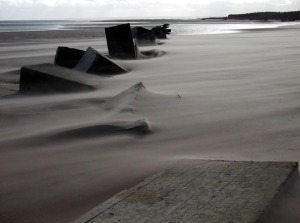It is all too easy to miss great walking opportunities right on your doorstep. The other day I was dropping some rubbish off at the local civic amenity site where, by chance, I stumbled upon a relatively new path network right next door.
The Riverside Nature Park has been created on top of what was for many years Dundee’s main landfill site. Now full to the brim, the city’s waste has been covered in a generous layer of topsoil and replanted. The result is a square mile of grassy meadow and young woodland located alongside the estuary of the River Tay.
To enable exploration, paths have been created, there is a viewpoint at the top and a bird hide has been constructed overlooking the mudflats of Invergowrie Bay. A car park is located on the southern edge of the park, reached from Riverside Drive via Wright Avenue.
After disposing of my waste, I donned my boots and set off, spending a good hour or so exploring the area. The longest stretch of path runs from the car park up to the bird hide by the bay. Returning, I had the option of heading over the top of the mound – where the viewpoint is located – or following a path that runs between North Meadow and open fields usually occupied by Highland cows. Here there is a small pond where two swans were in residence.
Continuing east, various paths skirt round fields and patches of woodland, emerging either into the car park or on to Wright Avenue, close to its junction with Riverside Drive.
The landfill site opened in 1967 as part of ongoing efforts to reclaim ground from the Tay Estuary (nearby Dundee Airport is built on artificially created land). The site closed in 1996 and has since been the subject of extensive landscaping. The meadows have been planted with an array of wildflowers and there are various patches and strips of native woodland.
One of the highlights is the opportunity to spot wading birds on the adjacent mudflats. Geese are regular visitors while other species you may see include lapwing, shelducks, oystercatchers and curlews. The Tay Estuary is also home to white-tailed sea eagles, which were released over the water in Tentsmuir Forest as part of an ongoing reintroduction scheme. Mammals which frequent Invergowrie Bay include otters.
For more information click here to open a copy of the park information leaflet (with map) in pdf format.
















